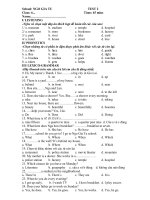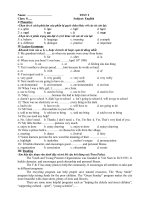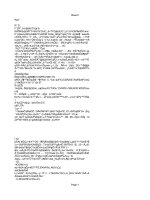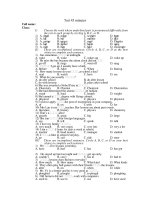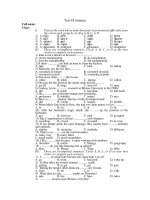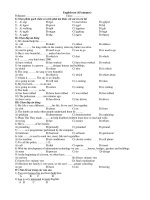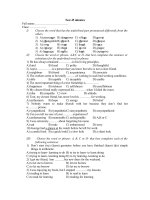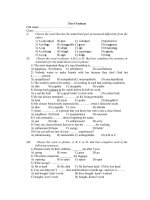FCE Reading full test teacher handbook 08
Bạn đang xem bản rút gọn của tài liệu. Xem và tải ngay bản đầy đủ của tài liệu tại đây (340.24 KB, 6 trang )
Part 1
You are going to read an extract from a novel. For questions 1 – 8, choose the answer (A, B, C or D)
which you think fits best according to the text.
Mark your answers on the separate answer sheet.
I shifted uncomfortably inside my best suit and eased a finger inside the tight white
collar. It was hot in the little bus and I had taken a seat on the wrong side where the
summer sun beat on the windows. It was a strange outfit for the weather, but a few
miles ahead my future employer might be waiting for me and I had to make a good
impression.
There was a lot depending on this interview. Many friends who had qualified with
me were unemployed or working in shops or as labourers in the shipyards. So many
that I had almost given up hope of any future for myself as a veterinary surgeon.
There were usually two or three jobs advertised in the Veterinary Record each
week and an average of eighty applicants for each one. It hadn’t seemed possible when
the letter came from Darrowby in Yorkshire. Mr S. Farnon would like to see me on the
Friday afternoon; I was to come to tea and, if we were suited to each other, I could stay
on as his assistant. Most young people emerging from the colleges after five years of
hard work were faced by a world unimpressed by their enthusiasm and bursting
knowledge. So I had grabbed the lifeline unbelievingly.
line 15
The driver crashed his gears again as we went into another steep bend. We had
been climbing steadily now for the last fifteen miles or so, moving closer to the distant
blue of the Pennine Hills. I had never been in Yorkshire before, but the name had
always raised a picture of a region as heavy and unromantic as the pudding of the same
name; I was prepared for solid respectability, dullness and a total lack of charm. But as
the bus made its way higher, I began to wonder. There were high grassy hills and wide
valleys. In the valley bottoms, rivers twisted among the trees and solid grey stone
farmhouses lay among islands of cultivated land which pushed up the wild, dark
hillsides.
Suddenly, I realised the bus was clattering along a narrow street which opened
onto a square where we stopped. Above the window of a small grocer’s shop I read
‘Darrowby Co-operative Society’. We had arrived. I got out and stood beside my
battered suitcase, looking about me. There was something unusual and I didn’t know
what it was at first. Then it came to me. The other passengers had dispersed, the driver
had switched off the engine and there was not a sound or a movement anywhere. The
only visible sign of life was a group of old men sitting round the clock tower in the
centre of the square, but they might have been carved of stone.
Darrowby didn’t get much space in the guidebooks, but where it was mentioned it
was described as a grey little town on the River Arrow with a market place and little of
interest except its two ancient bridges. But when you looked at it, its setting was
beautiful. Everywhere from the windows of houses in Darrowby you could see the
hills. There was a clearness in the air, a sense of space and airiness that made me feel I
had left something behind. The pressure of the city, the noise, the smoke – already
they seemed to be falling away from me.
Trengate Street was a quiet road leading off the square and from there I had my
first sight of Skeldale House. I knew it was the right place before I was near enough to
read S. Farnon, Veterinary Surgeon on the old-fashioned brass nameplate. I knew by
the ivy which grew untidily over the red brick, climbing up to the topmost windows. It
was what the letter had said – the only house with ivy; and this could be where I would
work for the first time as a veterinary surgeon. I rang the doorbell.
1 As he travelled, the writer regretted his choice of
A seat.
B clothes.
C career.
D means of transport.
2 What had surprised the writer about the job?
A There had been no advertisement.
B He had been contacted by letter.
C There was an invitation to tea.
D He had been selected for interview.
3 The writer uses the phrase ‘I had grabbed the lifeline’ (line 15) to show that he felt
A confident of his ability.
B ready to consider any offer.
C cautious about accepting the invitation.
D forced to make a decision unwillingly.
4 What impression had the writer previously had of Yorkshire?
A It was a beautiful place.
B It was a boring place.
C It was a charming place.
D It was an unhappy place.
5 What did the writer find unusual about Darrowby?
A the location of the bus stop
B the small number of shops
C the design of the square
D the lack of activity
6 What did the writer feel the guidebooks had missed about Darrowby?
A the beauty of the houses
B the importance of the bridges
C the lovely views from the town
D the impressive public spaces
7 How did the writer recognise Skeldale House?
A The name was on the door.
B It had red bricks.
C There was a certain plant outside.
D It stood alone.
8 How did the writer’s attitude change during the passage?
A He began to feel he might like living in Darrowby.
B He became less enthusiastic about the job.
C He realised his journey was likely to have been a waste of time.
D He started to look forward to having the interview.
Turn Over ►
Part 2
You are going to read an article about a woman who is a downhill mountain-bike racer. Seven
sentences have been removed from the article. Choose from the sentences A – H the one which fits
each gap (9 – 15). There is one extra sentence which you do not need to use.
Mark your answers on the separate answer sheet.
Downhill racer
Anna Jones tells of her move from skiing to downhill mountain biking and her rapid rise up
the ranks to her current position as one of the top five downhill racers in the country
.
At the age of seven I had learnt to ski and
by fourteen I was competing internationally.
When I was eighteen a close friend was injured
in a ski race, and as a result, I gave up
competitive skiing. To fill the gap that skiing
had left I decided to swap two planks of wood for
two wheels with big tyres.
My first race was a cross-country race in 1995.
It wasn’t an amazing success.
9 After
entering a few more cross-country races, a local
bike shop gave me a downhill bike to try. I
entered a downhill race, fell off, but did
reasonably well in the end, so I switched to
downhill racing.
I think my skiing helped a lot as I was able to
transfer several skills such as cornering and
weight-balance to mountain biking. This year I’m
riding for a famous British team and there are
races almost every weekend from March through
to September.
10 In fact, there’s quite a
lot of putting up tents in muddy fields.
Last season I was selected to represent Great
Britain at both the European and World
Championships. Both events were completely
different from the UK race scene.
11 I
was totally in awe, racing with the riders I had
been following in magazines. The atmosphere
was electric and I finished about mid-pack.
Mountain biking is a great sport to be in. People
ask me if downhill racing is really scary. I say,
‘Yes it is, and I love it.’ Every time I race I scare
myself silly and then say, ‘Yeah let’s do it again.’
When you’re riding well, you are right on the
edge, as close as you can be to being out of
control.
12 However, you quickly learn
how to do it so as not to injure yourself. And it’s
part of the learning process as you have to push
yourself and try new skills to improve.
Initially, downhill racing wasn’t taken seriously as a
mountain-biking discipline.
13 But things
are changing and riders are now realising that
they need to train just as hard for downhill racing
as they would do for cross-country.
The races are run over ground which is generally
closer to vertical than horizontal, with jumps,
drop-offs, holes, corners and nasty rocks and
trees to test your nerves as well as technical
skill. At the end of a run, which is between two
and three minutes in this country your legs hurt
so much they burn.
14 But in a race,
you’re so excited that you switch off to the pain
until you’ve finished.
A lot of people think that you need to spend
thousands of pounds to give downhill mountain
biking a go.
15 A reasonable beginner’s
downhill bike will cost you around £400 and the
basic equipment, of a cycle helmet, cycle shorts
and gloves, around £150. Later on you may
want to upgrade your bike and get a full-face
crash helmet, since riders are now achieving
speeds of up to 80 kilometres per hour.
A
B
C
D
I’ve fallen off more times than I care to
remember.
I usually have to stop during practice
sessions.
The courses were twice as long and the
crowds were twice as big.
I’m not strong enough in my arms, so I’ve
been doing a lot of upper-body training
this year.
E
F
G
H
The attitude was: how much skill do you
need to sit on a saddle and point a bike
in the same direction for a few minutes?
I finished last, but it didn’t matter as I
really enjoyed it.
Nothing could be further from the truth.
It’s not all stardom and glamour, though.
Turn Over ►
Part 3
You are going to read a magazine article about people who collect things. For questions 16 – 30,
choose from the people (A – D). The people may be chosen more than once.
Mark your answers on the separate answer sheet.
Which person
had to re-start their collection?
16
has provided useful advice on their subject?
17
was misled by an early success?
18
received an unexpected gift?
19
admits to making little practical use of their collection?
20
regrets the rapid disappearance of certain items?
21
is aware that a fuller collection of items exists elsewhere?
22
has a history of collecting different items?
23
performed a favour for someone they knew?
24
is a national expert on their subject?
25
is aware that they form part of a growing group?
26
insists on purchasing top-quality items?
27
noticed items while looking for something else?
28
has to protect their collection from damage?
29
would like to create a hands-on display of their collection?
30
The World of Collecting
A
Ron Barton shares his home with about 200
sewing machines. His passion began when he
was searching for bits of second-hand furniture
and kept seeing ‘beautiful old sewing machines
that were next to nothing to buy’. He couldn’t
resist them. Then a friend had a machine that
wouldn’t work, so she asked Barton to look at it
for her. At that stage he was not an authority
on the subject, but he worked on it for three
days and eventually got it going.
Later he opened up a small stand in a
London market. ‘Most people seemed
uninterested. Then a dealer came and bought
everything I’d taken along. I thought, “Great!
This is my future life.” But after that I never
sold another one there and ended up with a
stall in another market which was only
moderately successful.’
Nowadays, he concentrates on domestic
machines in their original box containers with
their handbooks. He is often asked if he does
any sewing with them. The answer is that,
apart from making sure that they work, he
rarely touches them.
B
As a boy, Chris Peters collected hundreds of
vintage cameras, mostly from jumble sales and
dustbins. Later, when the time came to buy his
first house, he had to sell his valuable
collection in order to put down a deposit. A few
years after, he took up the interest again and
now has over a thousand cameras, the earliest
dating from 1860.
Now Peters ‘just cannot stop collecting’ and
hopes to open his own photographic museum
where members of the public will be able to
touch and fiddle around with the cameras.
Whilst acknowledging that the Royal Camera
Collection in Bath is probably more extensive
than his own, he points out that ‘so few of the
items are on show there at the same time that I
think my own personal collection will easily
rival it.’
C
Sylvia King is one of the foremost authorities
on plastics in Britain. She has, in every corner
of her house, a striking collection of plastic
objects of every kind, dating from the middle of
the last century and illustrating the complex
uses of plastic over the years.
King’s interest started when she was
commissioned to write her first book. In order
to do this, she had to start from scratch; so she
attended a course on work machinery,
maintaining that if she didn’t understand
plastics manufacture then nobody else would.
As she gathered information for her book,
she also began to collect pieces of plastic from
every imaginable source: junk shops, arcades,
and the cupboards of friends. She also
collects ‘because it is vital to keep examples.
We live in an age of throw-away items: tape-
recorders, cassettes, hair dryers – they are all
replaced so quickly.’
King’s second book, Classic Plastics: from
Bakelite to High Tech, is the first published
guide to plastics collecting. It describes
collections that can be visited and gives simple
and safe home tests for identification.
King admits that ‘plastic is a mysterious
substance and many people are frightened of
it. Even so, the band of collectors is constantly
expanding.’
D
Janet Pontin already had twenty years of
collecting one thing or another behind her
when she started collecting ‘art deco’ fans in
1966. It happened when she went to an
auction sale and saw a shoe-box filled with
them. Someone else got them by offering a
higher price and she was very cross. Later, to
her astonishment, he went round to her flat
and presented them to her. ‘That was how it
all started.’ There were about five fans in the
shoe-box and since then they’ve been
exhibited in the first really big exhibition of ‘art
deco’ in America. The fans are not normally
on show, however, but are kept behind glass.
They are extremely fragile and people are
tempted to handle them. The idea is to have,
one day, a black-lacquered room where they
can be more easily seen.
Pontin doesn’t restrict herself to fans of a
particular period, but she will only buy a fan if it
is in excellent condition. The same rule
applies to everything in her house.
